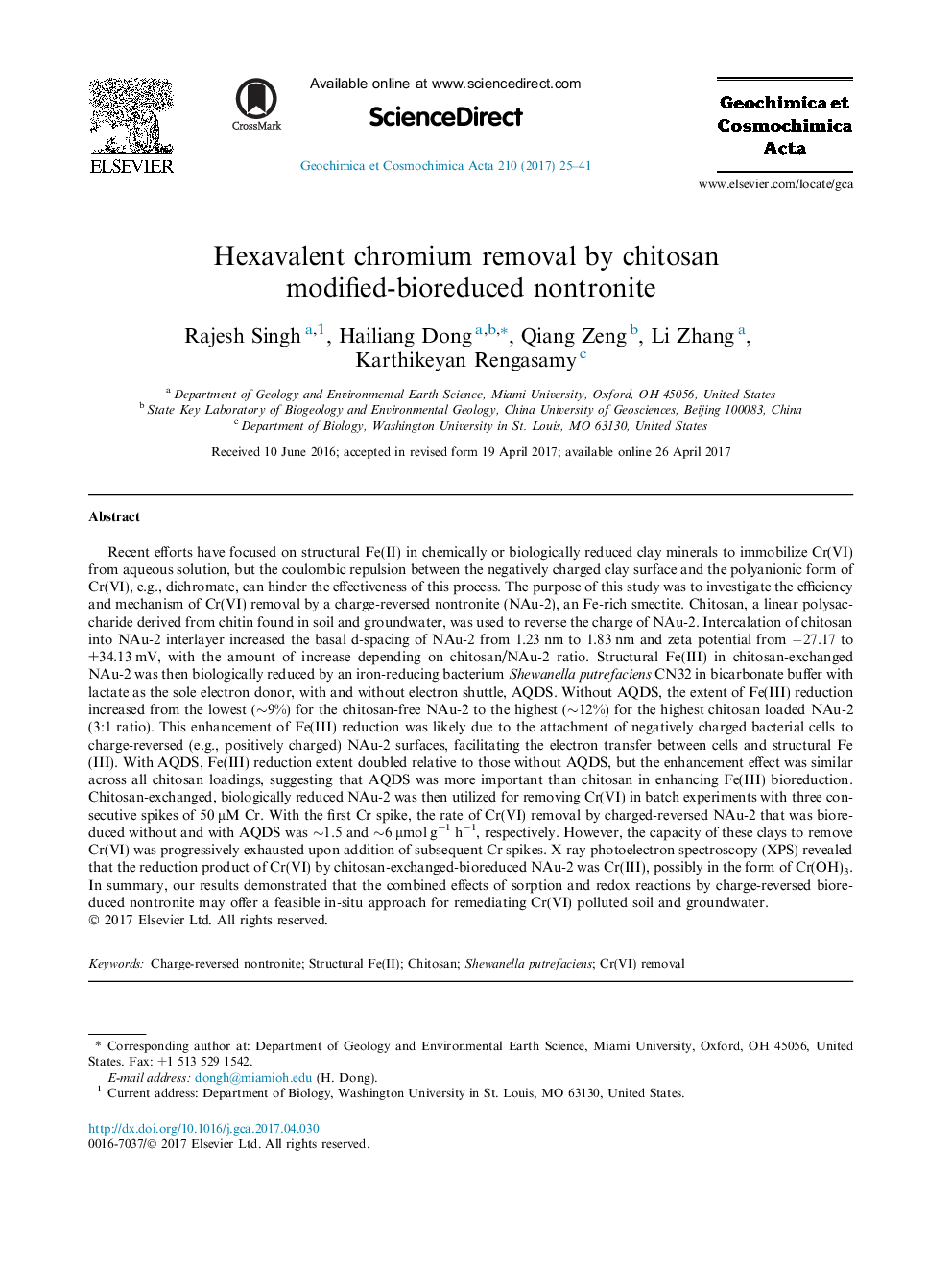| کد مقاله | کد نشریه | سال انتشار | مقاله انگلیسی | نسخه تمام متن |
|---|---|---|---|---|
| 5783189 | 1637947 | 2017 | 17 صفحه PDF | دانلود رایگان |
Recent efforts have focused on structural Fe(II) in chemically or biologically reduced clay minerals to immobilize Cr(VI) from aqueous solution, but the coulombic repulsion between the negatively charged clay surface and the polyanionic form of Cr(VI), e.g., dichromate, can hinder the effectiveness of this process. The purpose of this study was to investigate the efficiency and mechanism of Cr(VI) removal by a charge-reversed nontronite (NAu-2), an Fe-rich smectite. Chitosan, a linear polysaccharide derived from chitin found in soil and groundwater, was used to reverse the charge of NAu-2. Intercalation of chitosan into NAu-2 interlayer increased the basal d-spacing of NAu-2 from 1.23 nm to 1.83 nm and zeta potential from â27.17 to +34.13 mV, with the amount of increase depending on chitosan/NAu-2 ratio. Structural Fe(III) in chitosan-exchanged NAu-2 was then biologically reduced by an iron-reducing bacterium Shewanella putrefaciens CN32 in bicarbonate buffer with lactate as the sole electron donor, with and without electron shuttle, AQDS. Without AQDS, the extent of Fe(III) reduction increased from the lowest (â¼9%) for the chitosan-free NAu-2 to the highest (â¼12%) for the highest chitosan loaded NAu-2 (3:1 ratio). This enhancement of Fe(III) reduction was likely due to the attachment of negatively charged bacterial cells to charge-reversed (e.g., positively charged) NAu-2 surfaces, facilitating the electron transfer between cells and structural Fe(III). With AQDS, Fe(III) reduction extent doubled relative to those without AQDS, but the enhancement effect was similar across all chitosan loadings, suggesting that AQDS was more important than chitosan in enhancing Fe(III) bioreduction. Chitosan-exchanged, biologically reduced NAu-2 was then utilized for removing Cr(VI) in batch experiments with three consecutive spikes of 50 µM Cr. With the first Cr spike, the rate of Cr(VI) removal by charged-reversed NAu-2 that was bioreduced without and with AQDS was â¼1.5 and â¼6 µmol gâ1 hâ1, respectively. However, the capacity of these clays to remove Cr(VI) was progressively exhausted upon addition of subsequent Cr spikes. X-ray photoelectron spectroscopy (XPS) revealed that the reduction product of Cr(VI) by chitosan-exchanged-bioreduced NAu-2 was Cr(III), possibly in the form of Cr(OH)3. In summary, our results demonstrated that the combined effects of sorption and redox reactions by charge-reversed bioreduced nontronite may offer a feasible in-situ approach for remediating Cr(VI) polluted soil and groundwater.
Journal: Geochimica et Cosmochimica Acta - Volume 210, 1 August 2017, Pages 25-41
